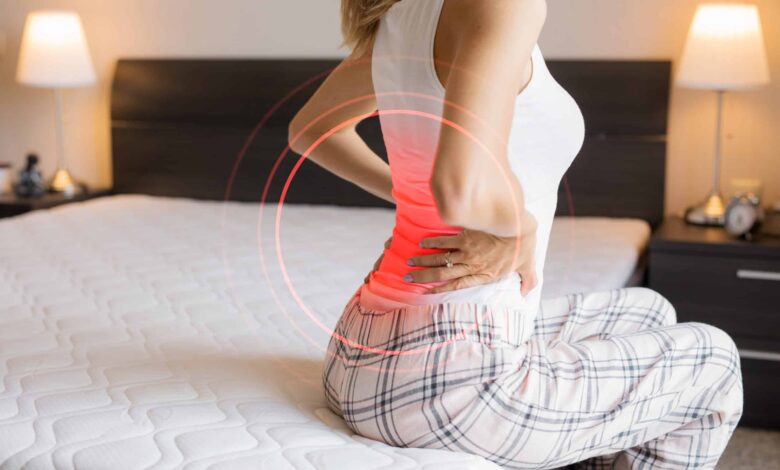What Features Make a Mattress Good for Back Pain

Back pain can significantly impact sleep quality and overall well-being. Choosing the right mattress is crucial for those seeking relief. A good mattress for back pain typically offers a balance of support and comfort, with medium-firm to firm options generally recommended.
When selecting a mattress to alleviate back pain, key features to consider include proper spinal alignment, pressure point relief, and adequate support. Memory foam and hybrid mattresses often excel in these areas, contouring to the body’s shape while maintaining necessary support. Some mattresses incorporate zoned support systems, providing targeted relief to different areas of the body.
Personal preferences and sleeping positions play a role in determining the best mattress for individual needs. Side sleepers may benefit from slightly softer surfaces, while back and stomach sleepers often require firmer support. Many manufacturers offer sleep trials for those looking to buy mattresses online, allowing customers to test the product’s effectiveness in reducing back pain.
Key Takeaways
- Medium-firm to firm mattresses generally provide the best support for back pain relief
- Features like proper spinal alignment and pressure point relief are essential in a mattress for back pain
- Personal sleeping position and preferences should guide mattress selection
Key Mattress Features for Alleviating Back Pain
Selecting the right mattress can significantly impact back pain management. Certain features play crucial roles in providing comfort and support for those suffering from back issues.
Support and Firmness Level
Medium-firm to firm mattresses often provide the best support for back pain sufferers. These firmness levels help maintain proper spinal alignment while sleeping. A mattress that’s too soft can cause the body to sink, leading to poor posture and increased pain.
Firmness is typically rated on a scale of 1-10, with most back pain sufferers finding relief in the 5-7 range. The ideal firmness may vary based on body weight and sleeping position.
Edge support is another important factor. Strong edges prevent sagging and provide consistent support across the entire mattress surface.
Materials and Construction
Memory foam and latex are popular materials for back pain relief due to their pressure-relieving properties. High-density foam layers offer durability and prevent excessive sinking.
Hybrid mattresses combine foam layers with innerspring coils, providing a balance of comfort and support. The coils offer targeted support while foam layers contour to the body’s curves.
Some mattresses feature zoned support systems, with firmer areas under the hips and shoulders to maintain proper alignment. This design can be particularly beneficial for those with lower back pain.
Mattress Types and Their Advantages
Foam mattresses excel in pressure relief and motion isolation. They conform closely to the body, reducing pressure points that can exacerbate back pain.
Hybrid mattresses offer a combination of support and comfort. The coil base provides a sturdy foundation, while foam layers on top offer cushioning and contouring.
Innerspring mattresses with pillow tops can be a good option for those who prefer a more traditional feel. Look for models with individually wrapped coils for better motion isolation and targeted support.
Latex mattresses provide natural bounce and responsiveness. They offer pressure relief without the sinking feeling often associated with memory foam.
Considerations for Individual Needs
Selecting the right mattress for back pain requires a personalized approach. Factors like sleep position, body type, and specific comfort needs all play crucial roles in finding the ideal mattress.
Sleeping Positions and Body Type
Side sleepers often benefit from softer mattresses that cushion pressure points at the hips and shoulders. A medium-soft to medium firmness level typically works well. Back sleepers generally need more support, with medium to medium-firm mattresses helping maintain proper spinal alignment.
Stomach sleepers require firmer surfaces to prevent the hips from sinking too deeply. Body weight also impacts mattress choice. Heavier individuals may need firmer mattresses for adequate support, while lighter people might prefer softer options for pressure relief.
Combination sleepers should look for responsive mattresses that allow easy position changes throughout the night.
Additional Factors for Enhanced Sleep Quality
Temperature regulation is crucial for uninterrupted sleep. Look for mattresses with cooling properties like gel-infused foams or breathable latex layers. These features help dissipate body heat and maintain a comfortable sleep environment.
For those with specific pain issues, zoned support systems can provide targeted relief. These designs offer firmer support in areas like the lower back while cushioning pressure points.
Consider mattresses with motion isolation properties if you share the bed. This feature minimizes disturbances from a partner’s movements, promoting better sleep quality for both individuals.
Accompanying Products for Optimal Comfort
Pillows play a vital role in spinal alignment and can complement your mattress choice. Side sleepers benefit from thicker pillows, while back and stomach sleepers typically need thinner options.
Mattress toppers can fine-tune firmness levels and add extra comfort layers. They’re especially useful if your current mattress is close to ideal but needs slight adjustment.
An adjustable base can significantly enhance comfort for back pain sufferers. It allows customization of sleep positions, potentially alleviating pressure on the lower back and improving overall sleep quality.
Consider waterproof mattress protectors to safeguard your investment and maintain hygiene. Look for options that don’t compromise the mattress’s comfort or cooling properties.
Conclusion
Choosing a mattress for back pain requires careful consideration of several key factors. Proper support, pressure relief, and firmness level tailored to individual needs are crucial elements. Medium-firm mattresses often provide an optimal balance for many back pain sufferers.
High-quality materials and construction can enhance durability and maintain consistent support over time. Ultimately, personal comfort and pain reduction should guide the selection process. Testing different options and consulting with healthcare professionals can help identify the most suitable mattress for alleviating back pain.



